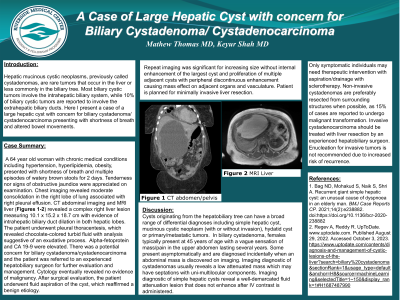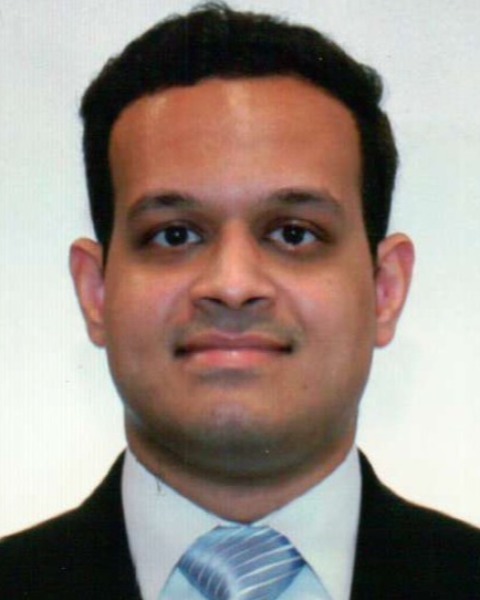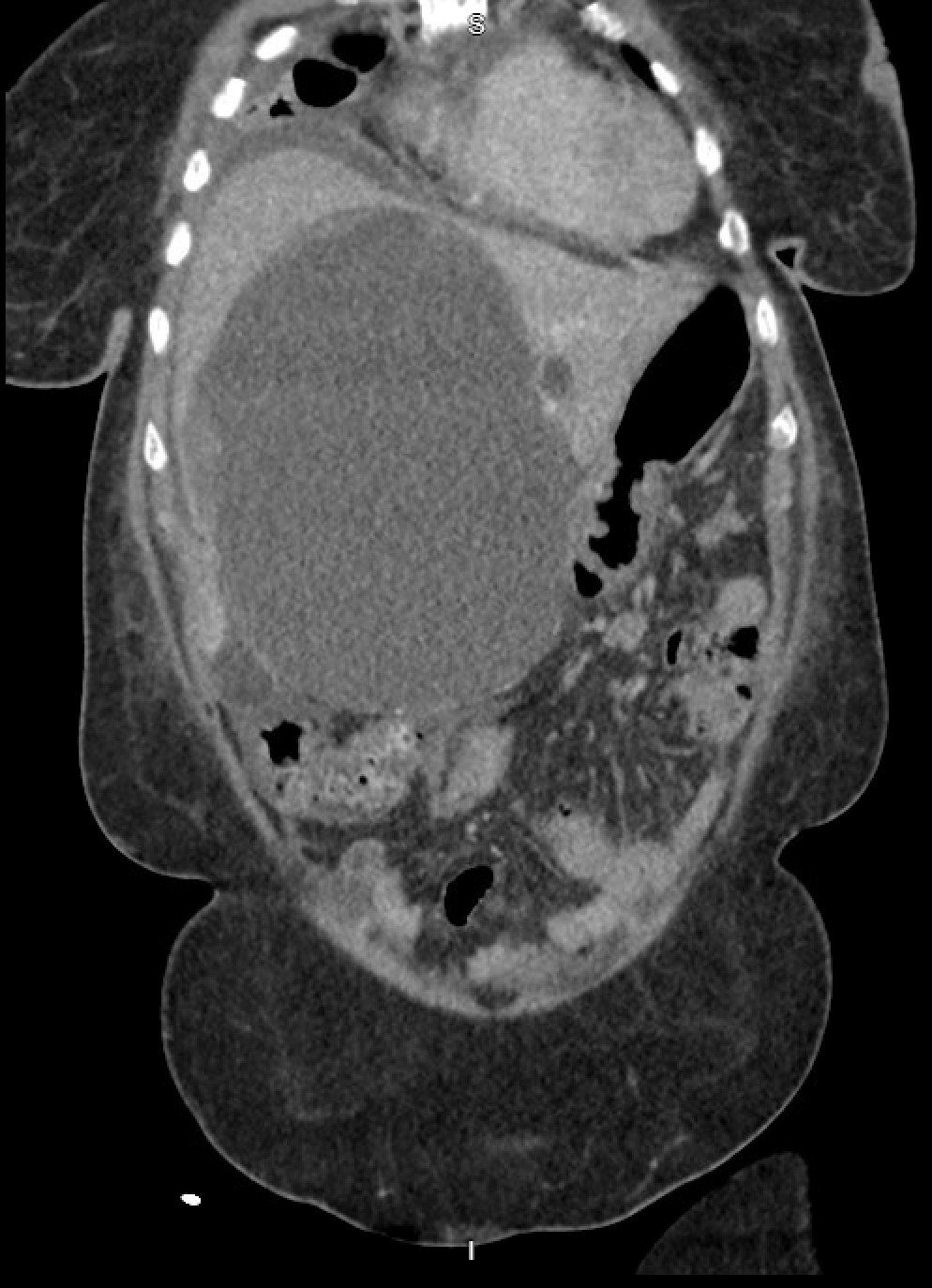Monday Poster Session
Category: Biliary/Pancreas
P1490 - Case Report on Biliary Cystadenoma
Monday, October 23, 2023
10:30 AM - 4:15 PM PT
Location: Exhibit Hall

Has Audio

Mathew A. Thomas, MD
Riverside Medical Center
Kankakee, IL
Presenting Author(s)
Mathew A. Thomas, MD
Riverside Medical Center, Kankakee, IL
Introduction: Hepatic mucinous cystic neoplasms, previously called cystadenomas, are rare tumors that occur in the liver or less commonly in the biliary tree. Most biliary cystic tumors involve the intrahepatic biliary system, while 10% of biliary cystic tumors are reported to involve the extrahepatic biliary ducts. Here we present a case of biliary cystadenoma with concern for biliary cystadenocarcinoma presenting with altered bowel movements.
Case Description/Methods: A 64-year-old woman with chronic medical conditions including hypertension, hyperlipidemia, class I obesity (BMI 31 kg/m²), presented with multiple episodes of watery stools for 2 days. Abdominal exam was unremarkable. Tenderness was not appreciated, nor were any signs of obstructive jaundice. CA 19-9 and alpha-fetoprotein were elevated. CT abdomen pelvis revealed a massive 10.2 x 15.5 x 18.7 cm fluid attenuation complex cyst that appeared to involve segment IV with caudal extension to the portal system; there was also evidence of intrahepatic biliary duct dilation in the right and left hepatic lobes. MRI of liver was performed for further evaluation, which confirmed a complex right liver mass with a potential concern for biliary cystadenoma/cystadenocarcinoma. It was recommended that the patient be referred to an experienced hepatobiliary surgeon for complete surgical excision of the complex right liver mass.
Discussion: Biliary cystic tumors (ie, biliary cystadenoma (BCA), biliary cystadenocarcinoma (BCAC)) account for less than 5% of all hepatic cysts. BCA predominantly occurs in women while BCAC occurs more evenly in both sexes. In BCA, females typically present at 45 years of age with a vague sensation of upper abdominal mass or pain lasting several years. However, patients have also presented asymptomatically and are diagnosed incidentally when an abdominal mass is discovered on imaging studies. Imaging usually reveals a low attenuated mass which may have septations with uni-/multilocular components. Non-invasive cystadenomas are preferably resected when possible as 15% of cases are reported to undergo malignant transformation. Cystadenomas can be enucleated from surrounding structures. Partial excision and aspiration are not recommended as it causes recurrence and is associated with worse prognosis. Invasive cystadenocarcinoma should be treated with liver resection by an experienced hepatobiliary surgeon. Enucleation for invasive tumors is not recommended as this is associated with increased risk of recurrence.

Disclosures:
Mathew A. Thomas, MD. P1490 - Case Report on Biliary Cystadenoma, ACG 2023 Annual Scientific Meeting Abstracts. Vancouver, BC, Canada: American College of Gastroenterology.
Riverside Medical Center, Kankakee, IL
Introduction: Hepatic mucinous cystic neoplasms, previously called cystadenomas, are rare tumors that occur in the liver or less commonly in the biliary tree. Most biliary cystic tumors involve the intrahepatic biliary system, while 10% of biliary cystic tumors are reported to involve the extrahepatic biliary ducts. Here we present a case of biliary cystadenoma with concern for biliary cystadenocarcinoma presenting with altered bowel movements.
Case Description/Methods: A 64-year-old woman with chronic medical conditions including hypertension, hyperlipidemia, class I obesity (BMI 31 kg/m²), presented with multiple episodes of watery stools for 2 days. Abdominal exam was unremarkable. Tenderness was not appreciated, nor were any signs of obstructive jaundice. CA 19-9 and alpha-fetoprotein were elevated. CT abdomen pelvis revealed a massive 10.2 x 15.5 x 18.7 cm fluid attenuation complex cyst that appeared to involve segment IV with caudal extension to the portal system; there was also evidence of intrahepatic biliary duct dilation in the right and left hepatic lobes. MRI of liver was performed for further evaluation, which confirmed a complex right liver mass with a potential concern for biliary cystadenoma/cystadenocarcinoma. It was recommended that the patient be referred to an experienced hepatobiliary surgeon for complete surgical excision of the complex right liver mass.
Discussion: Biliary cystic tumors (ie, biliary cystadenoma (BCA), biliary cystadenocarcinoma (BCAC)) account for less than 5% of all hepatic cysts. BCA predominantly occurs in women while BCAC occurs more evenly in both sexes. In BCA, females typically present at 45 years of age with a vague sensation of upper abdominal mass or pain lasting several years. However, patients have also presented asymptomatically and are diagnosed incidentally when an abdominal mass is discovered on imaging studies. Imaging usually reveals a low attenuated mass which may have septations with uni-/multilocular components. Non-invasive cystadenomas are preferably resected when possible as 15% of cases are reported to undergo malignant transformation. Cystadenomas can be enucleated from surrounding structures. Partial excision and aspiration are not recommended as it causes recurrence and is associated with worse prognosis. Invasive cystadenocarcinoma should be treated with liver resection by an experienced hepatobiliary surgeon. Enucleation for invasive tumors is not recommended as this is associated with increased risk of recurrence.

Figure: Biliary cystadenoma measuring 10.2 x 15.5 x 18.7 cm
Disclosures:
Mathew Thomas indicated no relevant financial relationships.
Mathew A. Thomas, MD. P1490 - Case Report on Biliary Cystadenoma, ACG 2023 Annual Scientific Meeting Abstracts. Vancouver, BC, Canada: American College of Gastroenterology.
